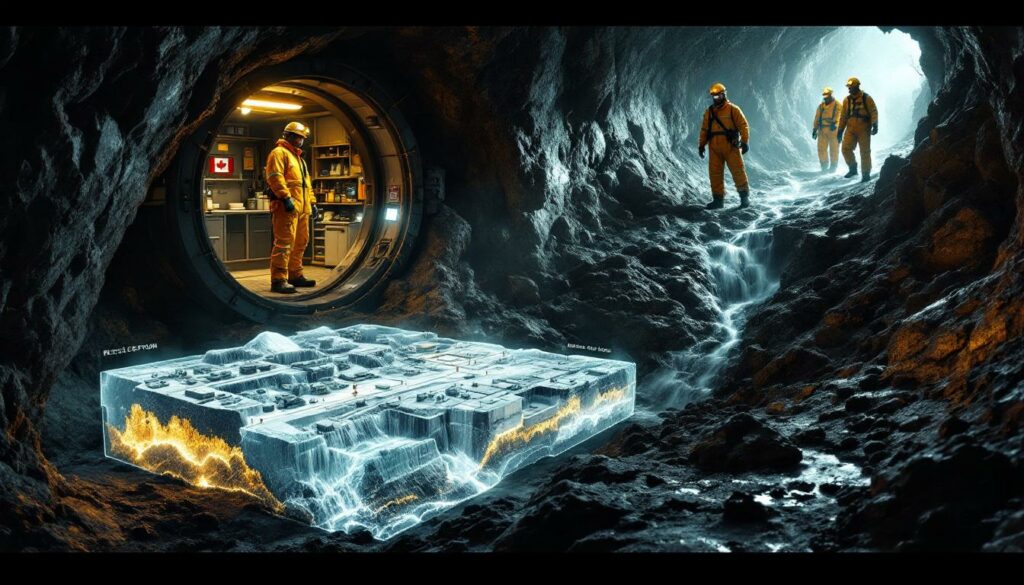Understanding the Red Chris Mine Incident
On July 22, 2025, three workers became trapped underground at the Red Chris mine in British Columbia, Canada, following two separate "fall of ground" incidents. These events disrupted access to a non-producing underground area of the mine, leaving the workers isolated in a refuge station. The incident has prompted a comprehensive rescue operation and raised questions about mine safety protocols in challenging underground environments.
According to a Newmont spokesperson, "The workers are, to the best of our knowledge, uninjured and safely positioned in a refuge area." This statement provides some reassurance amid the ongoing rescue efforts at the copper-gold operation located approximately 80 kilometers south of Dease Lake.
What Caused the Red Chris Mine Collapse?
The Sequence of Events Leading to the Entrapment
The situation unfolded through two distinct incidents on the morning of July 22. The initial "fall of ground" event prompted the relocation of three business partner employees to a designated refuge station. These workers were positioned more than 500 meters from the affected zone when the first incident occurred, allowing them sufficient time to reach safety.
Following this first event, mine officials established contact with the trapped employees, confirming they had successfully relocated to one of the mine's self-contained refuge bays. However, a subsequent second "fall of ground" incident further complicated the situation by completely blocking the accessway and disrupting all communication channels with the trapped workers.
Understanding "Fall of Ground" Incidents in Mining
A "fall of ground" incident refers to the unexpected collapse of rock from the ceiling or walls of a mine tunnel or excavation. These events can occur due to:
- Geological stress redistribution in deep mining operations
- Inadequate ground support systems
- Natural geological weaknesses in the rock structure
- Seismic activity in the surrounding area
- Water infiltration weakening rock formations
Such incidents represent one of the most serious hazards in underground engineering operations, particularly in areas with complex geological conditions. According to the Canadian Centre for Occupational Health and Safety (CCOHS), falls of ground remain among the leading causes of fatalities in underground mining environments despite advances in ground control technology.
Who Owns and Operates the Red Chris Mine?
Ownership Structure and Management
The Red Chris mine operates under a joint ownership structure:
- Newmont Corporation: Holds a 70% controlling interest in the mine
- Imperial Metals: Maintains a 30% ownership stake
Newmont, as the majority stakeholder, manages the day-to-day operations at the site. The company is one of the world's largest gold producers and has extensive experience in underground mining operations globally.
The Red Chris operation was acquired by Newmont as part of its merger with Newcrest Mining in November 2023, which was valued at approximately $17.5 billion. This acquisition significantly expanded Newmont's copper portfolio, positioning the company to capitalize on growing demand for the metal in renewable energy technologies.
Mine Location and Significance
Red Chris is located in northwestern British Columbia, Canada, approximately 80 kilometers south of Dease Lake. The mine primarily produces copper and gold and has been transitioning from open-pit to underground operations to access deeper, higher-grade ore deposits.
The underground expansion project, known as the Red Chris Block Cave, represents a significant capital investment aimed at extending the mine's productive life while targeting higher-grade mineralization. The project has been progressing with development of exploration declines and underground infrastructure.
How Are Mine Rescues Conducted in Underground Emergencies?
Refuge Stations: Critical Safety Infrastructure
Underground mines incorporate specialized refuge stations as a critical component of their emergency response systems. These stations provide:
- Sealed environments protected from hazardous conditions
- Independent air supplies and ventilation systems
- Emergency food and water provisions
- Communication equipment for contacting surface teams
- Medical supplies for treating potential injuries
The trapped workers at Red Chris were able to reach one of these refuge stations, which significantly improved their chances of survival during an extended rescue operation. Modern refuge chambers are designed to sustain miners for periods ranging from 36 to 96 hours, depending on their specifications and occupancy.
Rescue Operation Challenges and Approaches
The rescue effort at Red Chris faces several complex challenges:
- Blocked accessways: The fallen ground has completely obstructed normal entry routes
- Communication disruption: The second incident severed communication lines with the trapped workers
- Structural instability: Ongoing risk of additional collapses complicates rescue attempts
- Remote location: The mine's geographic position presents logistical challenges
Newmont has implemented a comprehensive response strategy that includes:
- Assembling specialist rescue teams from nearby mining operations
- Evaluating all available technological solutions to restore communication
- Implementing a complete standdown of operations to focus all resources on the rescue
- Exploring multiple potential approaches to safely reach the trapped workers
Mining rescue experts note that establishing communication is typically the first priority in such situations, often accomplished through drilling programs that can create small-diameter boreholes which can also deliver supplies if needed.
What Safety Measures Are Standard in Underground Mining?
Modern Mine Safety Protocols
Contemporary underground mining operations implement extensive safety preparations to protect workers, including:
- Ground control systems: Rock bolts, mesh, shotcrete and other supports to prevent collapses
- Monitoring technologies: Seismic and stress monitoring to detect potential instabilities
- Ventilation systems: Ensuring adequate air quality and temperature control
- Emergency response planning: Regular drills and clearly defined protocols
- Refuge chambers: Strategically placed safe havens with independent life support
- Communication infrastructure: Redundant systems to maintain contact with all underground personnel
Mining safety expert Dr. James Wilson of the Canadian Mining Safety Association explains: "Modern underground mines integrate multiple layers of protection, with ground control being the first line of defense against falls of ground. When preventive measures fail, emergency response systems like refuge chambers become critical lifesaving infrastructure."
Regulatory Oversight in Canadian Mining
Mining operations in British Columbia are subject to strict regulatory requirements through:
- The Health, Safety and Reclamation Code for Mines in British Columbia
- Ministry of Energy, Mines and Low Carbon Innovation inspections
- WorkSafeBC occupational health and safety standards
- Federal regulations governing mine safety practices
These regulatory frameworks establish minimum standards for ground control, emergency preparedness, and rescue capabilities that all operating mines must maintain. The Canadian Standards Association (CSA) standard Z1600-17, "Emergency and Continuity Management Program," provides additional guidance for emergency preparedness in mining operations.
How Common Are Mining Accidents in Canada?
Statistical Context of Mining Incidents
While the Canadian mining industry has made significant safety improvements over recent decades, underground operations still present inherent risks:
- Fatal incidents have decreased approximately 90% since the 1930s
- Modern mining in Canada averages 5-10 fatalities annually across all operations
- "Fall of ground" incidents remain among the leading causes of serious mining accidents
- Remote operations in challenging geological conditions face elevated risk profiles
According to data from the Association of Workers' Compensation Boards of Canada (AWCBC), the mining industry recorded 7 workplace fatalities in 2023, representing a fatality rate of approximately 8.4 per 100,000 workers. This represents a significant improvement from historical rates but highlights the ongoing risks associated with extractive industries.
The incident at Red Chris represents a relatively rare but serious event in the context of Canadian mining operations. British Columbia's Ministry of Energy, Mines and Low Carbon Innovation reported only two "fall of ground" incidents resulting in worker entrapment over the past decade prior to this event.
What Resources Are Available for Trapped Miners?
Survival Provisions in Refuge Stations
Modern refuge stations are designed to sustain miners during extended emergency situations with:
- Breathable air: Either through compressed air cylinders, chemical scrubbers that remove carbon dioxide, or connections to surface air supplies
- Water supplies: Typically sufficient for 36-72 hours depending on the number of occupants
- Food rations: High-calorie, long-shelf-life emergency provisions
- Sanitation facilities: Basic accommodations for extended stays
- Psychological support tools: Communication devices, instructions, and sometimes entertainment options to maintain morale
The Red Chris mine's refuge stations are equipped with these essential provisions, giving the trapped workers a secure environment while rescue operations proceed. Canadian mining regulations require these stations to be maintained and inspected regularly to ensure operational readiness.
The CSA standard Z365-17, "Mine Refuge Chamber Life Support Systems," establishes specific requirements for the design and performance of refuge chambers, including minimum air quality standards and occupancy duration capabilities.
What Is Newmont's Response to the Incident?
Immediate Actions and Corporate Response
Newmont has implemented a comprehensive response strategy that includes:
- Complete operational standdown: All mining activities at Red Chris have been suspended to focus entirely on the rescue effort
- Specialist team deployment: Expert rescue personnel from nearby operations have been mobilized
- Technological assessment: Evaluation of all available methods to restore communication and access
- Regular public updates: Transparent communication about the situation and rescue progress
- Family support: Resources for the families of the trapped workers
A Newmont spokesperson confirmed at a televised press conference that the workers were, to the best of their knowledge, uninjured and safely positioned in a refuge area. The company has also established a dedicated incident command center at the mine site to coordinate rescue operations.
Industry analysts note that Newmont's response aligns with best practices for mining emergency management, particularly the immediate operational standdown and deployment of specialized rescue resources. The company's public communications have been praised for transparency while respecting the privacy of affected families.
What Are the Next Steps in the Rescue Operation?
Potential Rescue Approaches
The rescue operation will likely pursue multiple parallel strategies:
- Clearing existing passages: Attempting to safely remove fallen material from blocked accessways
- Creating alternative routes: Potentially drilling or excavating new access points to reach the refuge station
- Establishing communication: Deploying specialized equipment to restore contact with the trapped workers
- Continuous monitoring: Assessing ground stability and environmental conditions throughout the affected areas
- Medical preparation: Ensuring appropriate medical resources are ready when workers are reached
The specific approach will depend on ongoing assessments of ground stability, the exact location of the trapped workers, and the technical feasibility of different rescue methods. Mining rescue consultants suggest that establishing communication through small-diameter boreholes will likely be prioritized to confirm the workers' status and provide psychological support during the rescue operation.
"In situations like this, maintaining ground stability during rescue operations becomes the primary technical challenge," explains mining engineer Dr. Sarah Chen. "Rescue teams must balance the urgency of reaching trapped workers with the paramount need to prevent secondary collapses that could endanger both the trapped individuals and rescue personnel."
How Does This Compare to Other Mine Rescue Operations?
Historical Context of Mine Rescues
The Red Chris incident shares characteristics with several notable mine rescues:
- 2010 Copiapó mining accident (Chile): 33 miners trapped for 69 days before successful rescue through a specially drilled shaft and rescue capsule
- 2016 Lily Mine collapse (South Africa): Three workers trapped in a container following a crown pillar collapse, with rescue attempts ultimately unsuccessful after multiple secondary collapses
- 2021 Totten Mine incident (Canada): 39 workers trapped but successfully rescued after climbing 4,000 feet through a secondary egress over approximately 24-36 hours
These previous incidents demonstrate that successful rescues are possible even in challenging circumstances, though each situation presents unique technical and safety challenges. The Copiapó rescue in particular highlighted the importance of maintaining communication with trapped miners and the effectiveness of purpose-drilled rescue shafts when existing passages are compromised.
Mining safety analysts note that the Red Chris incident appears most similar to the Totten Mine case, where workers were able to reach refuge stations before evacuating through secondary egress routes. However, the reported blockage of accessways at Red Chris presents additional complications not present in the Totten case.
FAQs About the Red Chris Mine Incident
What is the current status of the trapped workers?
As of the latest reports, the three workers are believed to be uninjured and safely positioned in a designated refuge station. However, communication has been disrupted following the second "fall of ground" incident.
How long can the workers survive in the refuge station?
Modern mine refuge stations are typically equipped with provisions to sustain occupants for 36-72 hours or longer. The exact duration depends on the specific design of the refuge station and the number of occupants. Red Chris Mine's refuge stations are designed to comply with Canadian safety standards, which require a minimum of 36 hours of life support.
What caused the "fall of ground" incidents at Red Chris?
The exact cause of the incidents has not yet been determined. A comprehensive investigation will likely follow the rescue operation to identify contributing factors and prevent similar occurrences in the future. Potential factors include geological stress, inadequate ground support, or natural weaknesses in the rock structure.
Is the Red Chris mine known for safety issues?
Prior to this incident, there have been no widely reported major safety incidents at the Red Chris mine. A complete safety record review would be part of any post-incident investigation. The mine operates under Canadian regulatory oversight, including regular inspections by provincial mining authorities.
What other operations does Newmont have in Canada?
Newmont recently divested its Porcupine operation in Canada as part of a broader non-core asset divestiture program. The company maintains several other operations globally as one of the world's largest gold producers. Following its merger with Newcrest in 2023, Newmont's Canadian portfolio includes interests in the Brucejack and Red Chris mines in British Columbia.
What is the economic significance of the Red Chris mine?
The Red Chris mine is an important producer of copper and gold, with the ongoing underground expansion expected to access higher-grade ore bodies. The operation employs approximately 350 people and contributes significantly to the regional economy in northwestern British Columbia. The mine's copper production is strategically important as global demand for the metal increases with the transition to renewable energy technologies and evolving industry trends.
Seeking Major Mining Discoveries Before the Market Knows?
Discovery Alert's proprietary Discovery IQ model provides instant notifications when significant mineral discoveries are announced on the ASX, turning complex data into actionable investment insights. Explore why major discoveries like Red Chris can generate substantial returns by visiting Discovery Alert's dedicated discoveries page and position yourself ahead of the market.




